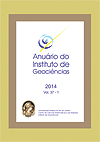Petrographic and mineralogical characterization of magmatic-hydrothermal breccia at Itatiaia alkaline complex, Rio de Janeiro state: occurrences of fluorite and REE minerals
DOI:
https://doi.org/10.11137/2014_1_05_16Abstract
The meso-cenozoic alkaline magmatism in Rio de Janeiro is represented by several plutonic/volcanic bodies, which occurred on W-E fracture and lineaments zones associated with the development of the Southeastern Brazilian Rift. One of main occurrences of those rocks is the Itatiaia Alkaline Complex (IAC), which consists of nepheline-syentite, dykes of trachyte/phonolite and magmatic-hydrothermal breccia. This paper shows petrographic and mineralogical caracterization (optical petrography, SEM-EDS and XRD analysis) of breccia. The breccia comprises lithoclasts of trachyte and cristaloclasts of biotite and K-feldspar immersed in microcrystalline groundmass. As hydrothermal mineral it were observed albite, carbonate, sanidine, clinochlore, pyrite (also in lithoclasts), biotite, apatite, fluorite, tourmaline, sericite, synchysite (À parisite), Nb-rutilo, sphalerite, epidote and orthoclase (adularia?). Minerals associated to weathering are gibbsite, melanterita and cancrinite. The new occurrences of fluorcarbonates (synchysite and parisite) and Nb-rutile at the IAC, are rare minerals commonly associated with hydrothermal alteration in alkaline-carbonatite complexes. The hydrothermal paragenesis, as well as comparison with data from other alkaline associations of Rio de Janeiro, suggests that the study rocks consist in late-magmatic/hydrothermal autobreccia, associated to epithermal systems of low sulphidation subtype and generated during interaction with low-temperature alkalic fluids. The description of fluorite and REE-minerals at IAC opens the possibility to find those minerals in other alkaline complex of Rio de Janeiro.Downloads
Download data is not yet available.
Downloads
Published
2014-06-01
How to Cite
Pires, G. L. C. (2014) “Petrographic and mineralogical characterization of magmatic-hydrothermal breccia at Itatiaia alkaline complex, Rio de Janeiro state: occurrences of fluorite and REE minerals”, Anuário do Instituto de Geociências. Rio de Janeiro, BR, 37(1), pp. 5–16. doi: 10.11137/2014_1_05_16.
Issue
Section
não definida
License
This journal is licensed under a Creative Commons — Attribution 4.0 International — CC BY 4.0, which permits use, distribution and reproduction in any medium, provided the original work is properly cited.















